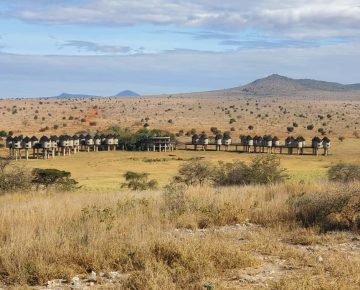Kakamega Forest National Reserve: A Jewel of Biodiversity in Kenya
Nestled in the western highlands of Kenya, Kakamega Forest National Reserve is a captivating destination renowned for its rich biodiversity and unique ecological features. Covering an area of approximately 240 square kilometers, this tropical rainforest is the last remnant of the ancient Equatorial rainforest that once spanned across East Africa. With its lush vegetation, diverse wildlife, and vibrant cultural heritage, Kakamega Forest serves as a vital ecological and cultural treasure, attracting researchers, nature enthusiasts, and tourists alike.

Geography and Ecosystem of Kakamega Forest National Reserve
Kakamega Forest is situated about 50 kilometers from Kisumu, the nearest city, and approximately 400 kilometers from Nairobi, the capital of Kenya. The forest lies at an elevation of 1,500 to 2,000 meters above sea level, providing a unique climate that supports a range of flora and fauna. The area experiences a humid tropical climate with two distinct rainy seasons: the long rains from March to May and the short rains from October to December.
The forest features a diverse topography, characterized by steep ridges, valleys, and numerous streams that create a network of waterways. These waterways are crucial for maintaining the ecosystem, supporting both plant and animal life. The vegetation is predominantly made up of tall trees, with some reaching heights of over 50 meters. Key tree species include the African yellowwood, red stinkwood, and various species of fig trees.
Flora
Kakamega Forest is home to over 300 species of trees, many of which are endemic to the region. The dense canopy provides a habitat for numerous plant species, including ferns, orchids, and medicinal plants. The undergrowth is rich with shrubs and flowering plants, creating a vibrant tapestry of colors and scents.
One of the remarkable features of the forest is its high level of plant diversity. Several species, such as the endangered Kakamega cicadabark tree, are found nowhere else in the world. The forest’s unique ecosystem is vital for research and conservation, as many of these plants play essential roles in the local economy and traditional medicine.
Fauna
Kakamega Forest is a biodiversity hotspot, hosting over 400 species of butterflies, 300 species of birds, and numerous mammals, reptiles, and amphibians. Some of the most notable wildlife includes:
Primates: The forest is home to several species of primates, including the endangered Colobus monkey, the blue monkey, and the vervet monkey. These primates are often seen swinging through the trees and are a major attraction for visitors.
Bird Species: Kakamega is a birdwatcher’s paradise, with over 300 species recorded, including the Great Blue Turaco, African Grey Parrot, and the White-thighed Hornbill. The forest provides critical habitat for both resident and migratory bird species, making it a vital area for avian conservation.
Mammals: In addition to primates, the forest is home to various mammals, including bush pigs, forest elephants, and small antelopes like the duiker. Though elusive, these animals play a crucial role in maintaining the forest’s ecological balance.
Insects and Reptiles: The forest’s humid environment supports a wide array of insects, including butterflies, beetles, and other pollinators. Reptiles such as chameleons and snakes are also common, contributing to the rich biodiversity of the ecosystem.
Conservation Efforts in Kakamega Forest National Reserve
The conservation of Kakamega Forest is crucial for preserving its unique biodiversity and supporting the livelihoods of local communities. Various organizations, including the Kenya Forest Service and local NGOs, are actively involved in conservation efforts. Key initiatives include:
Reforestation Projects: To combat deforestation and habitat loss, reforestation programs have been implemented. These projects aim to restore degraded areas of the forest by planting native tree species and enhancing the overall health of the ecosystem.
Community Engagement: Engaging local communities in conservation efforts is vital for the sustainability of the forest. Through education and awareness programs, residents are encouraged to participate in eco-friendly practices that benefit both the environment and their livelihoods.
Research and Monitoring: Ongoing research initiatives help monitor the health of the forest ecosystem. Scientists and conservationists study various aspects of the environment, including plant and animal populations, to inform conservation strategies.
Eco-Tourism: Promoting eco-tourism in Kakamega Forest helps generate revenue for conservation efforts while providing visitors with an opportunity to experience the forest’s natural beauty. Eco-friendly lodges and guided tours contribute to the local economy and foster a sense of stewardship among visitors.
Challenges facing Kakamega Forest Reserve
Despite its ecological significance, Kakamega Forest faces several challenges that threaten its biodiversity and sustainability:
Deforestation: Illegal logging and agricultural expansion are significant threats to the forest. The demand for land and timber has led to habitat loss, endangering many plant and animal species.
Climate Change: The impacts of climate change, such as altered rainfall patterns and increased temperatures, pose serious risks to the forest’s health. These changes can disrupt the delicate balance of the ecosystem and threaten vulnerable species.
Human-Wildlife Conflict: As human populations expand, conflicts between wildlife and local communities have increased. Crop raiding by elephants and other animals can lead to tension and resentment among residents, complicating conservation efforts.
Visitor Experience
Kakamega Forest offers a range of activities for visitors, making it an ideal destination for nature lovers, adventure seekers, and researchers. Some popular activities include:
Guided Nature Walks: Walking through the forest with a knowledgeable guide provides visitors with an opportunity to learn about the diverse flora and fauna. Guides share insights into the ecosystem, including medicinal plants and birdwatching tips.
Birdwatching: With its rich avifauna, Kakamega Forest is a haven for birdwatchers. Visitors can spot a variety of species, from colorful butterflies to rare birds, making it an unforgettable experience.
Camping and Lodging: For those wishing to immerse themselves in nature, camping facilities are available within the forest. Eco-lodges offer comfortable accommodations and allow visitors to experience the forest’s beauty up close.
Cultural Experiences: The local communities around Kakamega Forest have rich cultural traditions. Visitors can engage in cultural activities, including traditional dance performances and craft-making, deepening their understanding of the region’s heritage.
Ready to explore the reserve?
Kakamega Forest National Reserve stands as a remarkable testament to Kenya’s natural heritage. Its rich biodiversity, stunning landscapes, and cultural significance make it a valuable ecological treasure. As a vital ecosystem, the forest plays a crucial role in supporting both wildlife and local communities.
However, the challenges it faces require concerted efforts from conservationists, government agencies, and local populations. By promoting sustainable practices, enhancing community involvement, and embracing eco-tourism, we can ensure that Kakamega Forest thrives for generations to come. For anyone seeking adventure, knowledge, or a deeper connection with nature, Kakamega Forest offers an unparalleled experience that highlights the beauty and importance of one of Kenya’s most precious natural resources.















